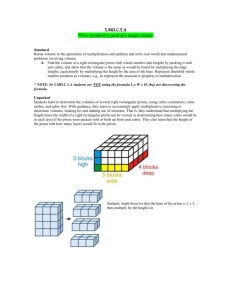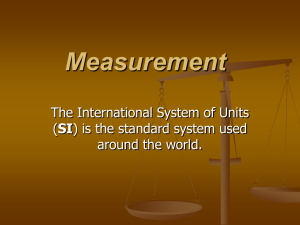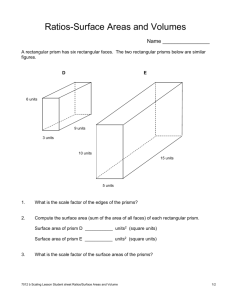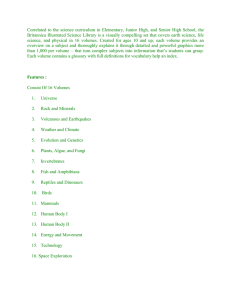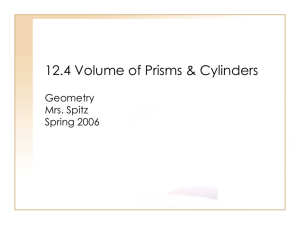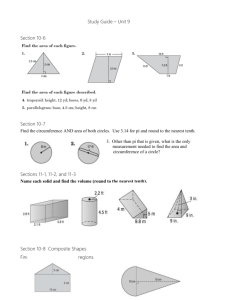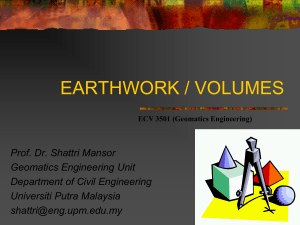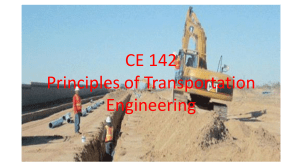Areas and Volume
advertisement
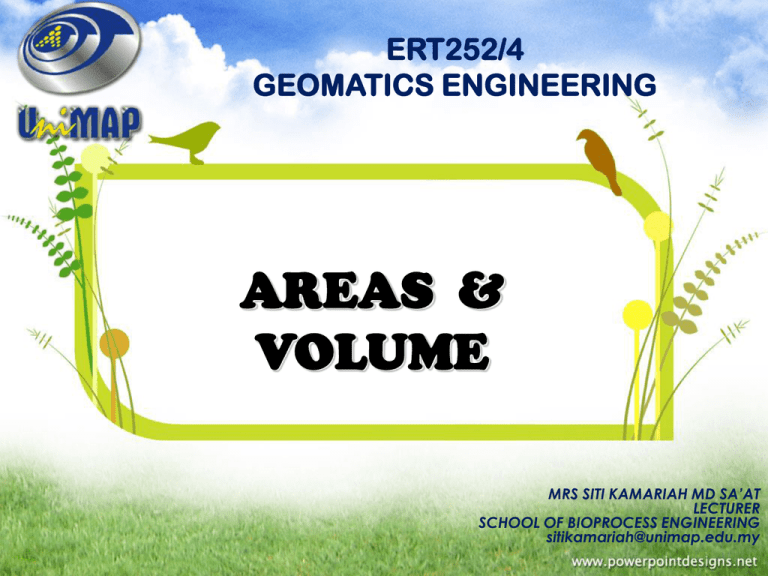
ERT252/4 GEOMATICS ENGINEERING AREAS & VOLUME MRS SITI KAMARIAH MD SA’AT LECTURER SCHOOL OF BIOPROCESS ENGINEERING sitikamariah@unimap.edu.my AREAS The computation of areas may be based on data scaled from plans or drawings, or direct from the survey field data. Prevalent methods of areas determination. Field measurements Dividing the areas into geometrical figures, offsets from base line and coordinates. Plan measurements Based on measurements from scaled plan or by the use of planimeter. Unit Conversion Areas by geometrical figures Trigonometric formula c 2 sin 2 B A 4 a (c a )(c a ) A 2 2 b cot B A 2 b 2 tan A A 2 Oblique triangle ab A 2 Areas from offset Trapezoidal Rule O1 O2 d 2 O O3 Area of second trapezoid 2 d 2 O On Area of last trape zoid n 1 d 2 O On O O2 O2 O3 A d 1 ... n 1 2 2 2 Area of first trap ezoid Simpson’s Rules Only for odd number of segments d A O1 4O2 2O3 4O4 ... 2On 2 4On 1 On 3 d A [(O1 On ) 4(O2 O4 ... On 1 ) 2(O3 O5 ...On 2 ) 3 Example 1 A tract of land has three straight boundaries AB, BC, and CD. The fourth boundary DA is irregular. The measured lengths are as under: AB = 135 m, BC = 191 m, CD = 126 m, BD = 255 m. The offsets measured outside the boundary DA to the irregular boundary at a regular interval of 30 m from D, are as below: Determine the area of the tract. Solution Example 1 Area ABD = 11604.42 m2 Area BCD = 11608.76 m2 Solution Example 1 A3 = 576 m2 So, total area = A1+A2+A3 = 23789.18 m2 Areas by coordinates By coordinates Y (N) X (E) YA XA YB XB YC XC YD XD YA XA 1 Area [(YA X B YB X C YC X D YD X A ) ( X AYB X BYC X CYD X DYA )] 2 1 Area YA ( X B X D ) YB ( X C X A ) YC ( X D X B ) YD ( X A X C ) 2 Example 2 The coordinates of traverse stations of a closed traverse ABCDE are given in Table 8.1. Calculate the area enclosed by the traverse. Ans: 148300 m2 Earthwork Sections Example 3 Calculate the area of cross-section that has breadth of formation as 10m, center height as 3.2 m and side slopes as 1 vertical to 2 horizontal. Solution Example 3 Given b = 10 m h = 3.2 m s= 2 Area = 52.48 m2 VOLUMES Persons engaged in surveying are often called to determine volumes of various types of material. The most common unit of volume is cubic having edges of unit length. Cubic feet, cubic yard or cubic meter. There are 3 methods to determining volume of land for cut and fill works: Cross section Method End Areas Method Prismoidal Method Cross Section Method The cross section method is employed almost exclusively for computing volumes on linear construction projects such as highways, railroads, and canals. Cut slopes of 1:1 ( 1 horizontal to 1 vertical ) and fill slope of 1-1/2:1 satisfactory for ordinary loam soil. Earthwork Sections Types Of Cross Sections In flat terrain the level section (a) is suitable . The three level section (b) is generally used where ordinary ground level is prevail. Rough topography may require a five level section (c). More practically an irregular section (d). A transition section (e), and slide hill section (f) occur when passing from cut to fill and on slide –hill locations. Types Of Cross Sections The width of base b , the finished roadway is fixed by project requirements and it is usually wider in cuts than on fills to provide for drainage ditches. Slide slops in fill are flatter than those in cuts where soil remains in its natural state. End Areas Method A1 and A2 are end areas at two stations separated by a horizontal distance L. The volume between two stations then equal to : Ve = A1 A2 xL 2 Prismoidal Method The prismoidal formula applies to volumes of all geometric solids that can be considered prismoids. Prismoidal Method • The prismoidal formula gives very nearly correct volume of earthwork even for irregular end sections and sides that are warped surfaces. • The prismoidal formula though being more accurate than end-areas rule, in practice the end-areas rule is more frequently adopted because of the ease of its application. • End-areas rule gives the computed volumes generally too great which is in favour of contractor. Prismoidal Method The difference between the volumes obtained by the average–end-areas formula and the prismoidal formula is called the prismoidal correction Cp . Cp L c1 c2 w1 w2 12 Where : Cp is the volume of the prismoidal correction c1 and c2 are center heights in cut or in fill W1 and W2 are widths of sections from slope intercept to slope intercept *If the product ( c1 - c2 ) ( w1 – w2 ) is minus , the prismoidal correction is added rather than subtracted from the end-area volume. Volume by Spot Level where A = the area of the square or rectangle, ΣhI = the sum of the vertical depths common to one prism, Σh2 = the sum of the vertical depths common to two prism, Σh3 = the sum of the vertical depths common to three prism, Σh4 = the sum of the vertical depths common to four prism. Volume from Contour By cross-sections By Equal Depth Contours By horizontal planes Sources of Error 1. 2. 3. 4. Making errors in measuring field cross-sections, e.g. Not being perpendicular to the centerline. Making errors in measuring end areas. Failing to use the prismoidal formula where it is justifies. Carrying out areas of cross sections beyond the limit justified by the field data. Exercise: For the tabulated, calculate the volume of excavation in cubic meter between stations 10+00 and 15+00. Station Cut End Area (m2 ) 10 +00 24.0 11 +00 30.6 12 +00 43.5 13 +00 37.4 14 +00 22.7 15 +00 10 THANK YOU
